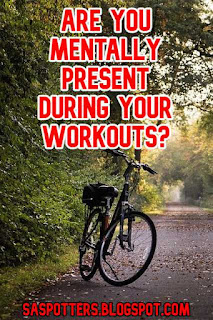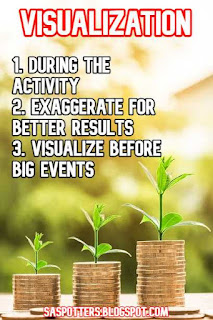What the mind can see the body can be
Imagine achieving that fitness goal that you really want.
When trainers like me write workout plans; we program all the exercises, sets, reps, and loads. This is basic preparation. After that we teach form. That’s necessary.
What do you do after that? Does you trainer tell you where to put your mental energy? Where are your thoughts?
If you are like most people, your thoughts are on worries or what needs to be done.
I teach people to put away any thoughts that aren’t about what you are doing right now. I teach mind-to-muscle to my clients. Focus on what the muscle is feeling and visualize what the muscle should be doing.
Proper mindset during a workout is important. It's more important than any other variable!
Visualization
Visualization is a technique that is taught in psychology. Visualization is also called imagery or guided imagery. I’ll use those terms interchangeably here.
It's forming a mental picture in your brain. Are you creative? Can you imagine vividly?
My first degree is in psychology. I first really learned about visualization when I was working on this degree.
Visualization works. It’s popular for a reason. If it didn’t work, it would not have stood the test of time.
Visualization leads to results. Research has shown that the brain reacts to visualization stimuli in the same way than if you were really doing the activity.
The brain and energy are powerful things. If we can see it our body can be it.
Visualization has been used in many different fields
Psychologists use it to help patients get over phobias and to induce relaxation responses. It is used in the business world to help prepare for sales. Visualization is used by psychologists and psychiatrists in in the medical field. It is used by educators to help students learn better. It is used by educators to help students with text anxiety. It is used in the sports industry.
One of the first studies I saw in sports psychology was visualization being used with basketball players to improve their free throw shooting. The basketball players would visualize themselves making free throws. Greater success came from people with more vivid imagery. The studies confirmed that it worked.
In one study, the basketball player’s practice was visualization alone. He improved his free throw shooting.
Finally, visualization is used in the fitness and wellness industry. Personally, I’m a big proponent of using it in my practice.
How to visualize while working out
Visualize during exercise like Arnold Schwarzenegger
The first time that I read about visualization and imagery being used in fitness was from Arnold Schwarzenegger.
Arnold spoke about his use of visualization and other sports psychology techniques often. Arnold told stories in his books and interviews about his use of imagery.
He would visualize the muscle groups and how he wanted them to look when he worked out. His focus was deep into what he was doing and he vividly imagined the outcome that he wanted.
Use bizarre imagery
He also used what is called 'bizarre imagery' in the sports psychology world. Bizarre imagery is using an exaggerated image of the effect hoped for. For example, Arnold wanted bigger shoulders so he would imagine giant boulders for shoulders.
Challenging, physical work is absolutely necessary for growth and improvement; but the brain is a powerful tool as well.
Practice visualization before the activity
Another area that successful physique athletes (bodybuilders) use visualization is with their posing routine. This part is critical in their competition. Physique athletes will imagine how they look on stage. They will visualize their entire posing routine beforehand.
I have personally used this for similar events - and other events where I perform - and I know that it helps me to get ready mentally.
We create patterns in the brain by doing this. When the actual routine is performed, the brain has already done it. It's a lot easier when you feel like you are doing it for the second time instead of the first!
There are different approaches that you can use regarding visualization in the gym - and outside of it. I say outside of it too because we shouldn't only use it for exercise.
I know plenty of runners and other endurance athletes that use it. Runners will visualize crossing the finish line fresh and fast. As they get tired, they imagine looking strong. Cyclists and swimmers all do the same thing. There are plenty of swimmers that visualize the time they want to hit while they are in the ready position on the starting board.
Focus on your muscle during exercise
When I train a client, I tell them to put their focus on the muscle while we work out. I ask them what it feels like as they are contracting that muscle. I encourage them to visualize the muscle doing the work.
I’ll often tell a client to close their eyes and really imagine their muscle doing the work. Think about the specific muscle as it is flexing or extending.
Once my trainees learn to place their focus there, they are amazed at how much more they get out of that set.
For those who want to add muscle density; I’ll encourage bizarre imagery and, depending on the area being worked, I’ll have them pick something that really gets their attention.
I will now take you, the reader, through guided imagery of different types:
Visualization routine during a bicep curl at the gym
You are doing dumbbell curls. Pick a load that you can get 10-12 clean reps with. Stand with erect posture and slightly bend your knees. Set your gaze slightly down (if you are ten feet away from a wall, gaze where wall meets floor). Close your eyes if you have the balance. Keep great form. Curl the weights up putting your mental focus on the feel of the biceps.
Now think about how you want those arms to look. Think of them as very cut and how awesome they look in a t-shirt or sleeveless dress. If you lose focus bring it back. Always keep good form and go through the full range of motion.
Go back to the bicep. How does it look? Can you imagine it looking ripped and vascular (If you like that)? Or can you imagine it looking cut and sinewy (if you like that)? Hold that photograph in your mind.
Visualization for runners
You are a runner and you want to improve your fitness. Get rid of all negative thinking. As you run think about your heart being strong and powerful. Think about it contracting with strength and pushing blood out to the muscles. Imagine yourself looking fresh as you run. Visualize your feet landing softly as your body feels light.
Visualization while you stretch
You are now stretching. Think about what the muscles do when they stretch. They are elongating. The muscle fibers are elongating. Put your focus on the muscle that you are stretching. Imagine that muscle being pliable. As you stretch, think about the muscle fibers elongating without resistance. Imagine the range of motion that you want to achieve and hold that vision. If your focus leaves the muscle, bring it back.
I’m a big believer in body, mind, and spirit. I know they all work together.
We must do the work physically. Knowing how to use your mental energy will help you with your physical goals.
Focus on what you want to achieve and really work at staying focused during your exercise. I believe it will help you a lot more than simply adding more weight or reps to your workout.
Quality is greater than quantity.
This article is written by Rob Maxwell, M.A. Exercise Physiology, CSCS and ACSM CPT from www.fittothemax.net. Follow him on Twitter.






No comments:
Post a Comment